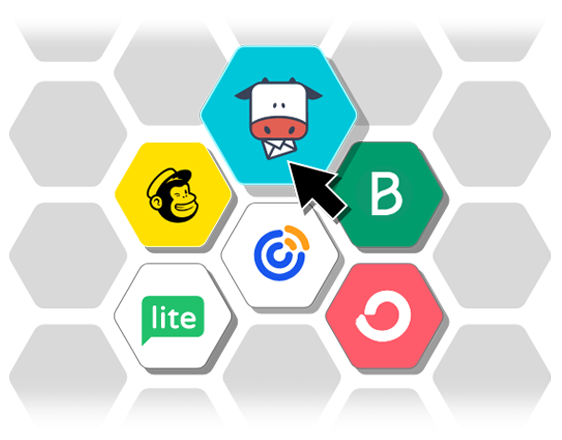You could say that ActiveCampaign vs Mailchimp is a battle of titans! On the one hand, ActiveCampaign, a well-established service known for its advanced automation options, and on the other hand, Mailchimp, a widely popular service across marketers able to deliver on-point features and a seamless experience.
Without further ado, let’s see what each service has to offer so you can decide which one is the most reasonable option for your business needs.
Save $$$ of your marketing budget by switching to Moosend today!
ActiveCampaign vs Mailchimp: Feature Comparison
Here we have a quick comparison table to get you started.
| ActiveCampaign | Mailchimp | |
| Free plan | No (14-day trial) | Yes (limited) |
| Pricing | $39/month (1,000 marketing contacts) | $26.50/month (1,500 contacts) |
| Best for | Agencies, eCommerce, Small businesses, Enterprises | eCommerce, Publishers, Enterprises |
| Email tools | Email designer, newsletter templates, signup forms, landing pages, personalization tools | Email builder, pre-made templates, signup forms, landing pages, content studio |
| CRM | Yes | Built-in CRM, Audience management |
| Marketing automation | Advanced automation workflows, split automations, goals, conversion tracking, eCommerce automation, Automations Map | Pre-made automated workflows, retargeting, product recommendations |
| Unique features | Lead scoring | Multivariate testing |
| Reporting & Analytics | Essential metrics (opens, clicks, industry average open rates, bounces) + deep data reporting | Essential metrics (opens, clicks, industry average open rates, bounces) |
| Deliverability | 93% | 91% |
| Integrations | 940+ | 330 |
| Customer support | 24/7 live chat & email support, guides, tutorials | Knowledge base, email support, chat and phone support |
Setup & Ease of Use
The first and most important aspect of an email marketing solution is its overall ease of use and how straightforward it is to set it up. This is what we’ll look into first.
ActiveCampaign:
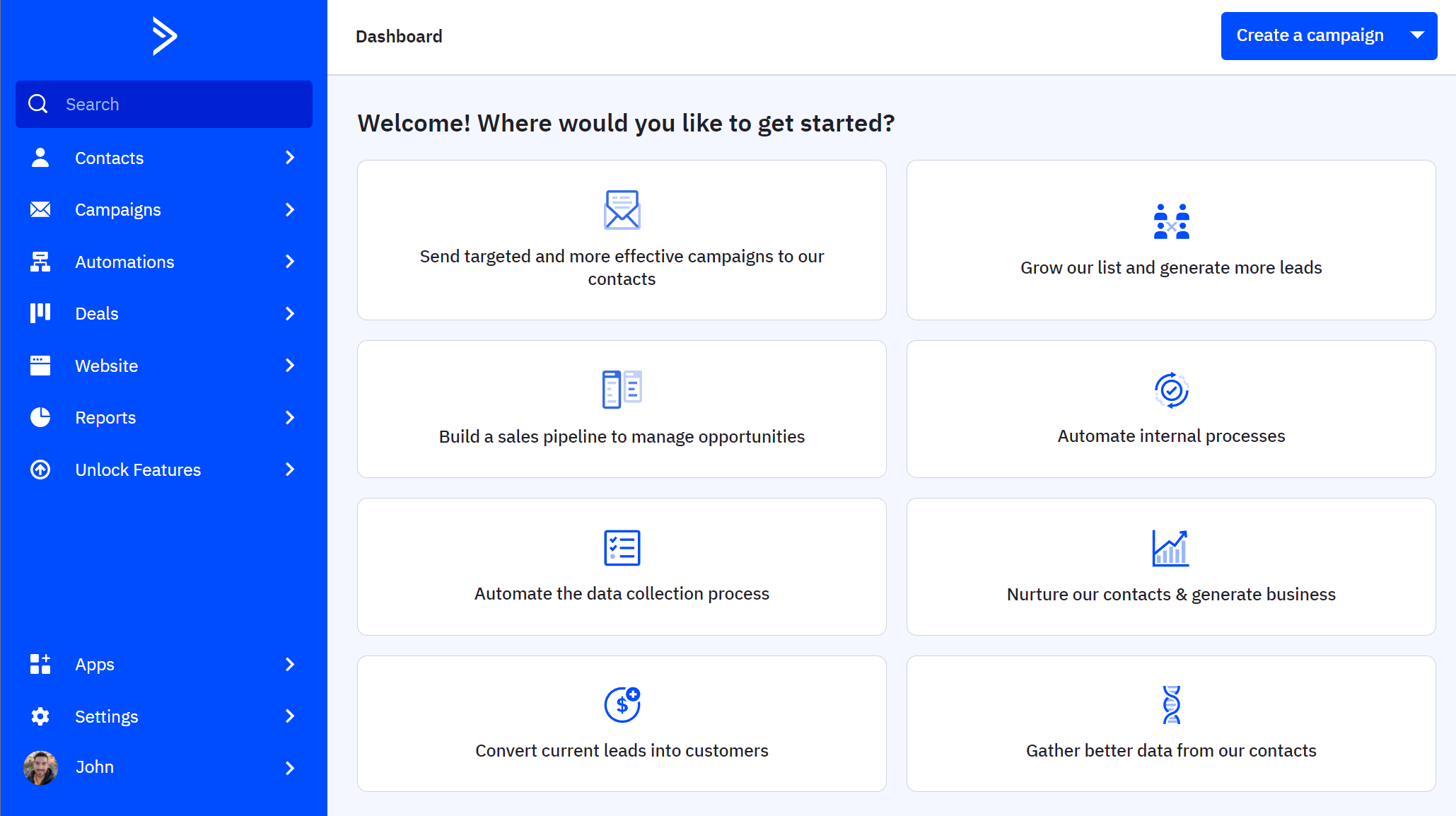
ActiveCampaign is a feature-packed platform. Yet the company has created a clean and straightforward user interface (all the tools are on the left sidebar) and navigation through the platform is great. What’s more, there are pop-up guides and video tutorials on the platform, but they are mostly relevant to the basic features.
Despite all these efforts, ActiveCampaign still has a steep learning curve (steeper than Mailchimp) and it will be most suitable for seasoned marketers rather than beginners, who may find themselves looking for answers to their problems on the web or customer support.
Mailchimp:
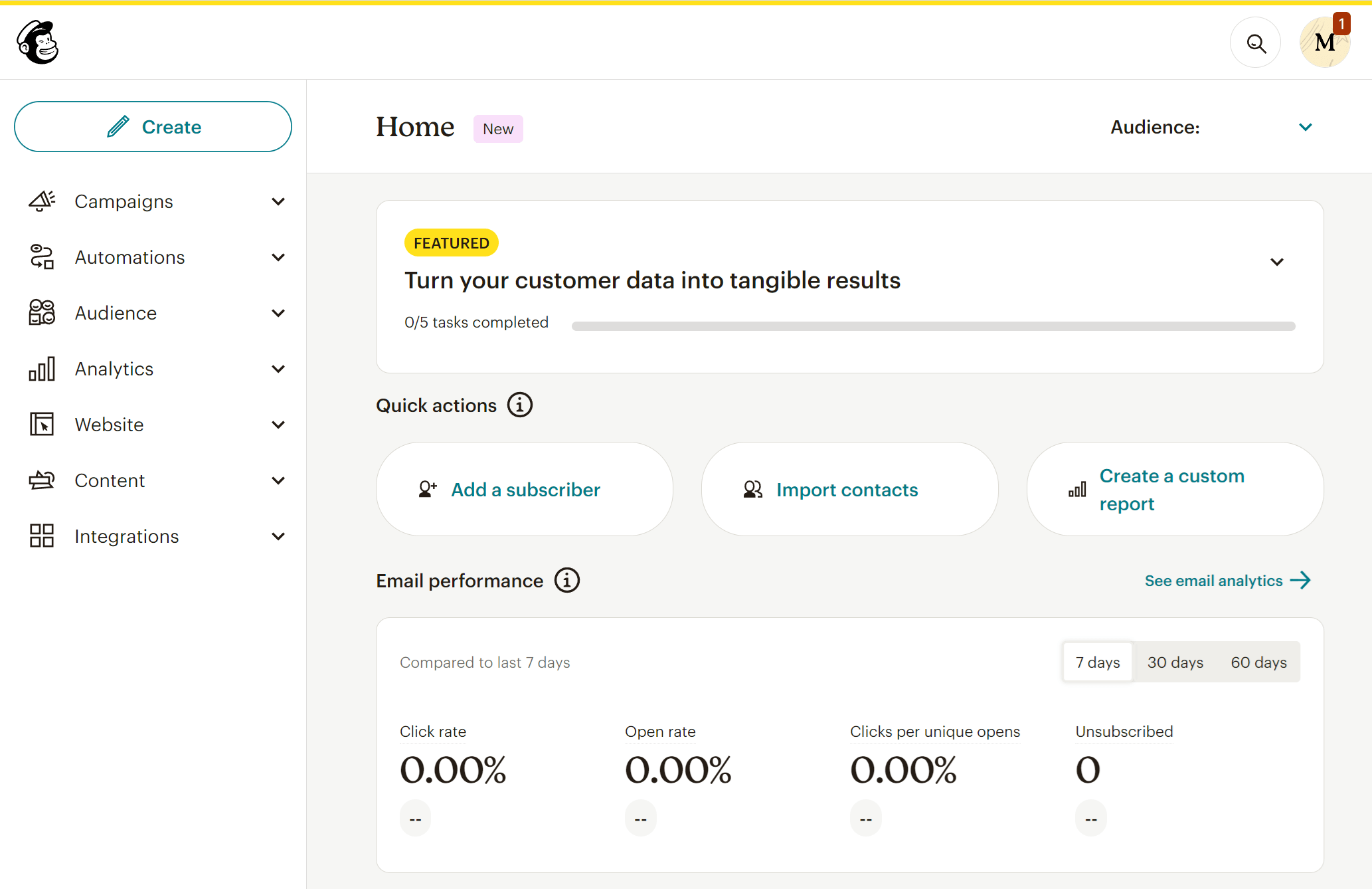
Mailchimp is much simpler and users will quickly master the platform and its features. Setting up your Mailchimp account requires only a few clicks, so you can finish everything in mere minutes. Navigation through the platform happens from the left sidebar, while there is also a handy “Create” button letting you craft your campaigns, automations, forms, and more without searching for the specific tab.
There is one problem, though. It’s not easy to find where your forms and landing pages go once you create them. Unless you know where to search, you may experience some “unnecessary” frustration. Nevertheless, the overall experience is great but there are a few things that the company could improve on.
Winner: For Activecampaign you’ll need to invest time and effort to make the most out of it. Mailchimp is easier to master, with lots of guided help for crucial features. This is why Mailchimp takes this win!
Email Builder
A great email marketing service helps users create email campaigns quickly and efficiently. Let’s see how ActiveCampaign and Mailchimp approach email creation.
ActiveCampaign:
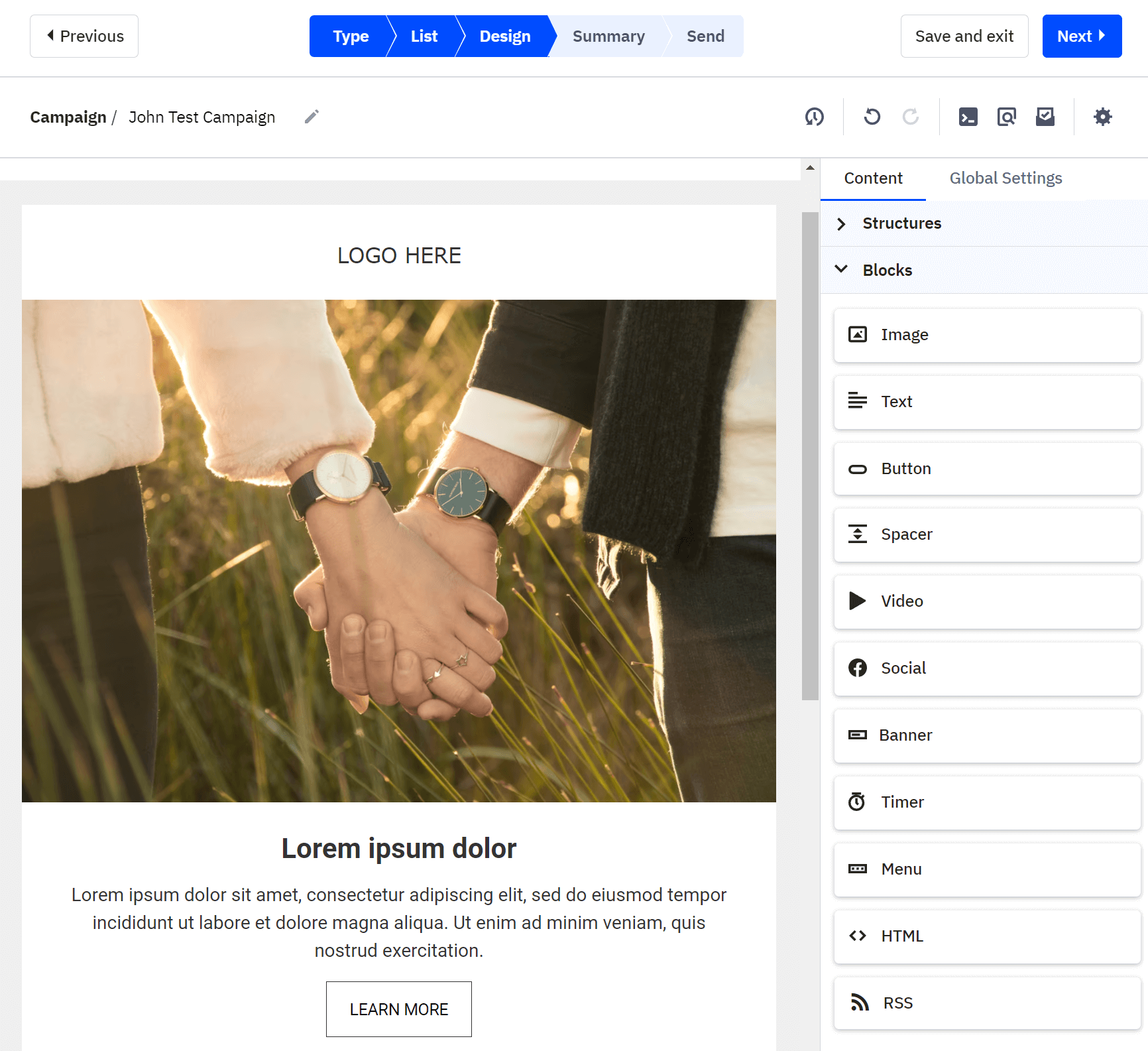
ActiveCampaign’s email builder is clean and features a wide range of blocks. You can insert simple elements like text, spacers, images and videos, while there are also advanced blocks such as timers, banners and blocks for eCommerce products. What’s great about the builder is the flexibility it provides in terms of structure. You can create almost anything that comes to your mind.
If your newsletters have “blocks” that stay the same in every campaign, then you’re in luck, since you can save those custom content blocks. ActiveCampaign users will also have an extra advantage over Mailchimp users when it comes to mobile formatting and conditional content. The if/then/else logic is straightforward even for beginners, while users can also dictate what “actions” will happen when email readers click on elements like images and links.
Mailchimp:
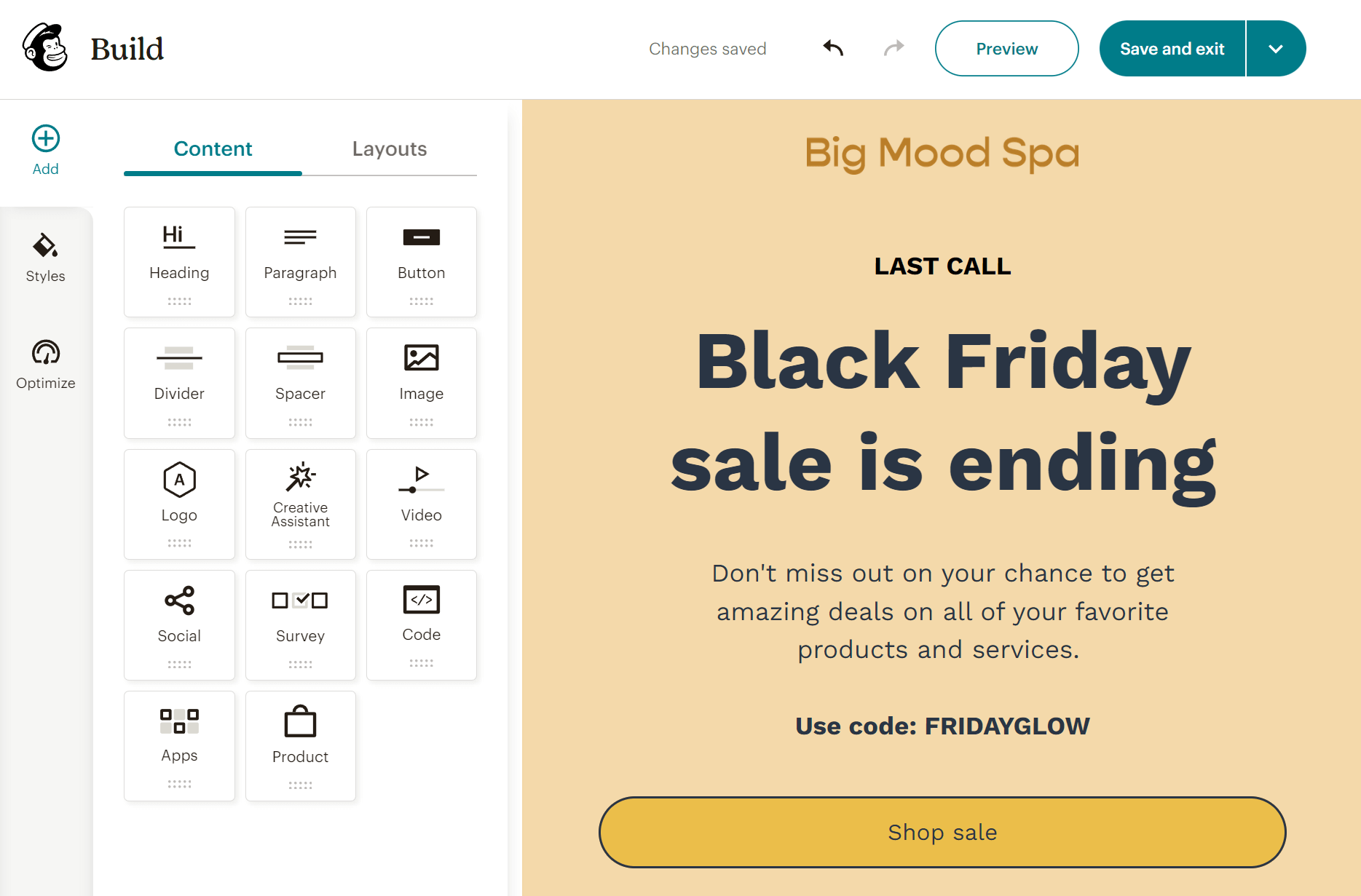
The email editor of Mailchimp is both intuitive and modern. The drag-and-drop functionality works great and users get various content blocks to infuse their campaigns with. For example, you have blocks for video, social media channels, eCommerce products, and surveys. For more unique designs you can even insert custom HTML code. To customize your content, you simply click on the block you want and make edits on it.
Another useful option of the Editor is the “Optimize” button, which allows you to find and fix errors in your campaign. Additionally, Mailchimp has a “Creative Assistant” feature that helps you generate beautiful designs. For the Assistant to work you need to input your website and Mailchimp will grab visuals and headings from it. Then it “feeds” you designs to use in your email campaign.
Winner: This was a tough decision. ActiveCampaign excels in giving you almost absolute freedom over customizability, but Mailchimp will be easier to master and smoother to work with overall. So our winner here is Mailchimp.
Templates
Now let’s see how the two competitors fare when it comes to template designs.
ActiveCampaign:
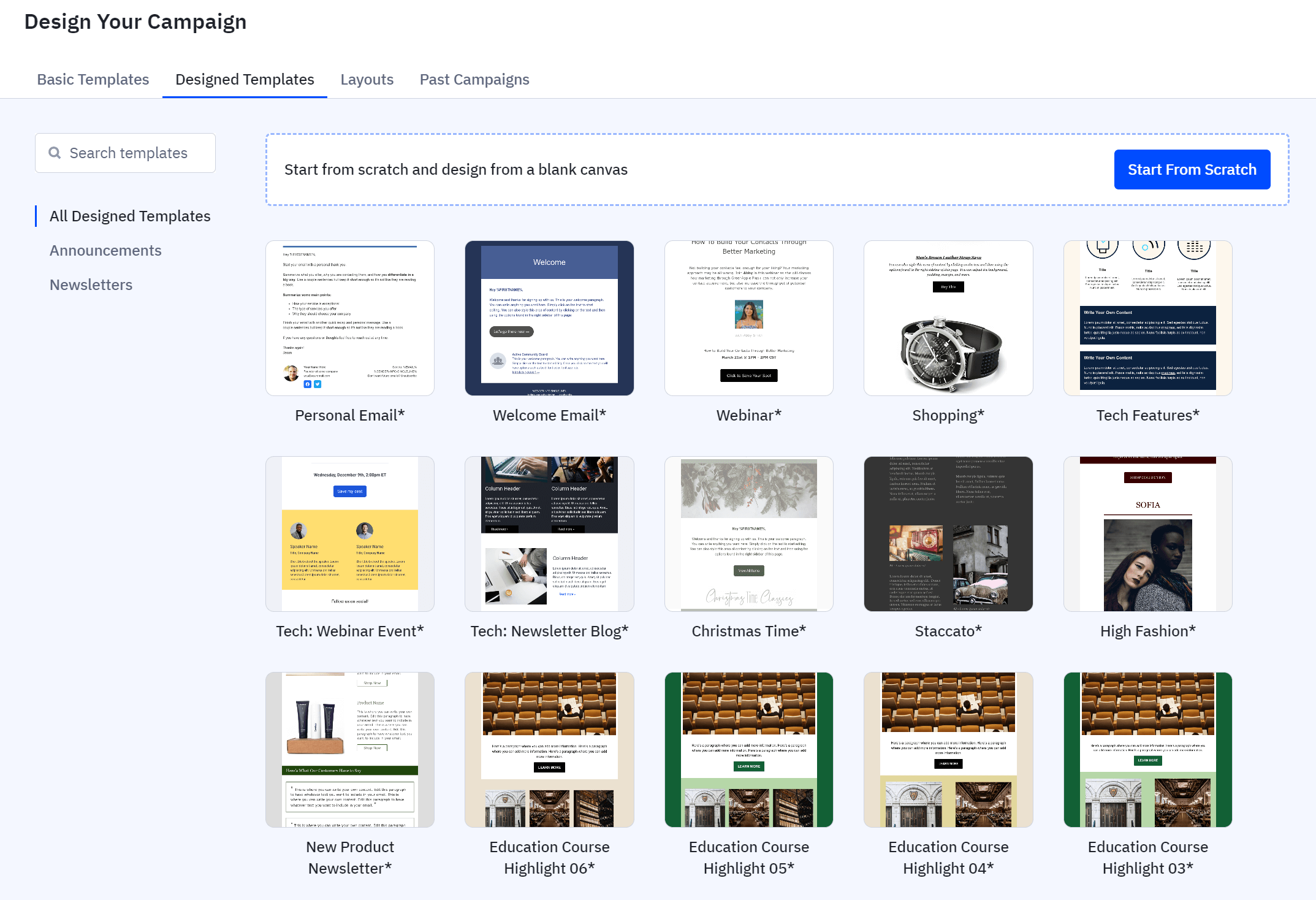
ActiveCampaign has a rich email template library of more than 250 designs. They are fully customizable so users can match their brand style and tone. What’s more, they are neatly named and organized so you can easily find one that fits your purposes, from cart abandonment and feedback reviews to product promotion and seasonal designs.
ActiveCampaign’s designs are modern and aesthetically pleasing, and they can be excellent starting points for beginners. They are also great if you want to craft a campaign in a few minutes. Last but not least, there is a free design service available on all Marketing plans. Essentially, you simply select a template and the company’s team makes the necessary customizations including your logo, brand colors, email copy, etc.
Mailchimp:
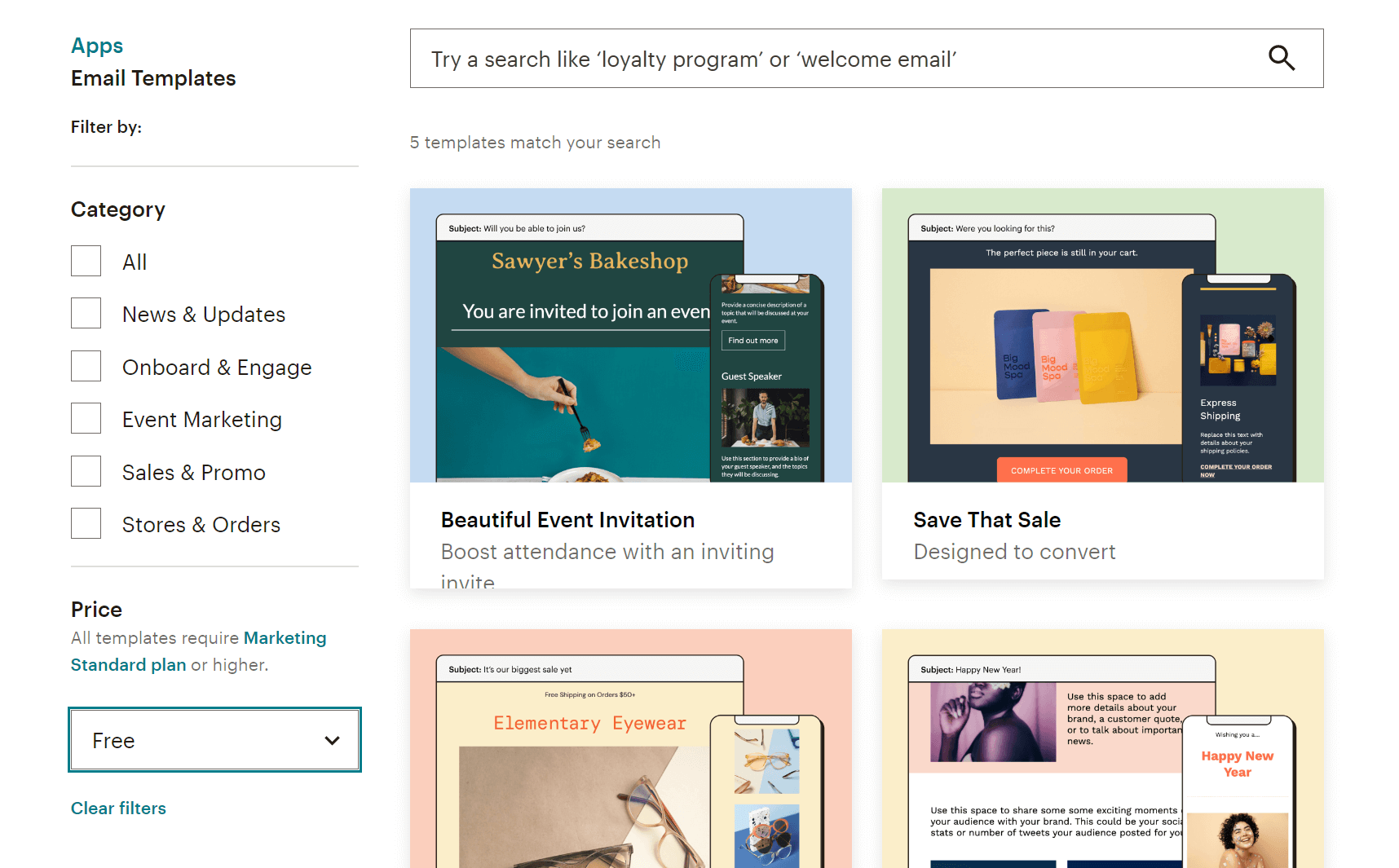
Mailchimp’s platform comes with 100+ email newsletter templates. They are professionally designed and look stunning. You can customize them to match your brand and needs, and they are categorized for easier navigation. You can find designs for lead nurturing and onboarding, sales and promotions as well as transactional templates. The main pain point here is that users of the Free Plan only have access to 8 basic templates.
Winner: ActiveCampaign is the winner here because its templates are available across all paid plans, unlike Mailchimp where you need at least the Standard plan.
Marketing Automation
Marketing automation offers marketers the ability to automate the customer journey and meet their customers at every step of the way. Moreover, marketing automation helps eliminate repetitive and time-consuming tasks.
ActiveCampaign:
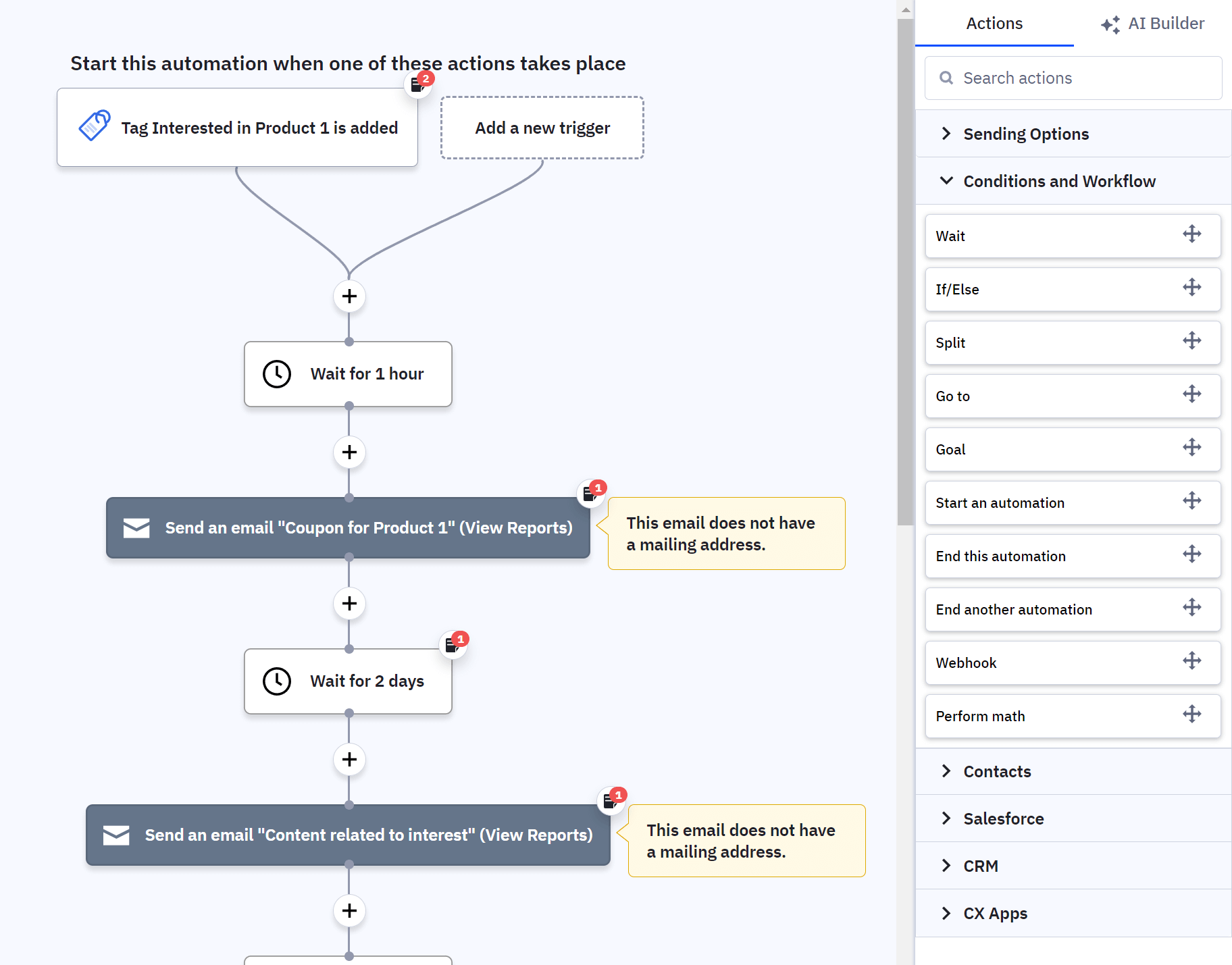
ActiveCampaign’s marketing automation capabilities are among the best in its category. There are options that you would expect to find in more expensive software. First of all, users can combine any number of triggers, actions, and conditions to create sophisticated workflows for sending emails, segmenting users, lead generation, and updating the CRM (add a deal, deal score, etc.). On top of that, there are 750+ automation recipes.
With ActiveCampaign you can also automate your SMS marketing efforts and your website messages. (Mailchimp has SMS marketing, but you need a third-party tool to include it in your automation journey).
Finally, ActiveCampaign has an Automations Map feature. Practically, this is a visualization tool so you get multiple automations in one map and see how they interact with each other.
Mailchimp:
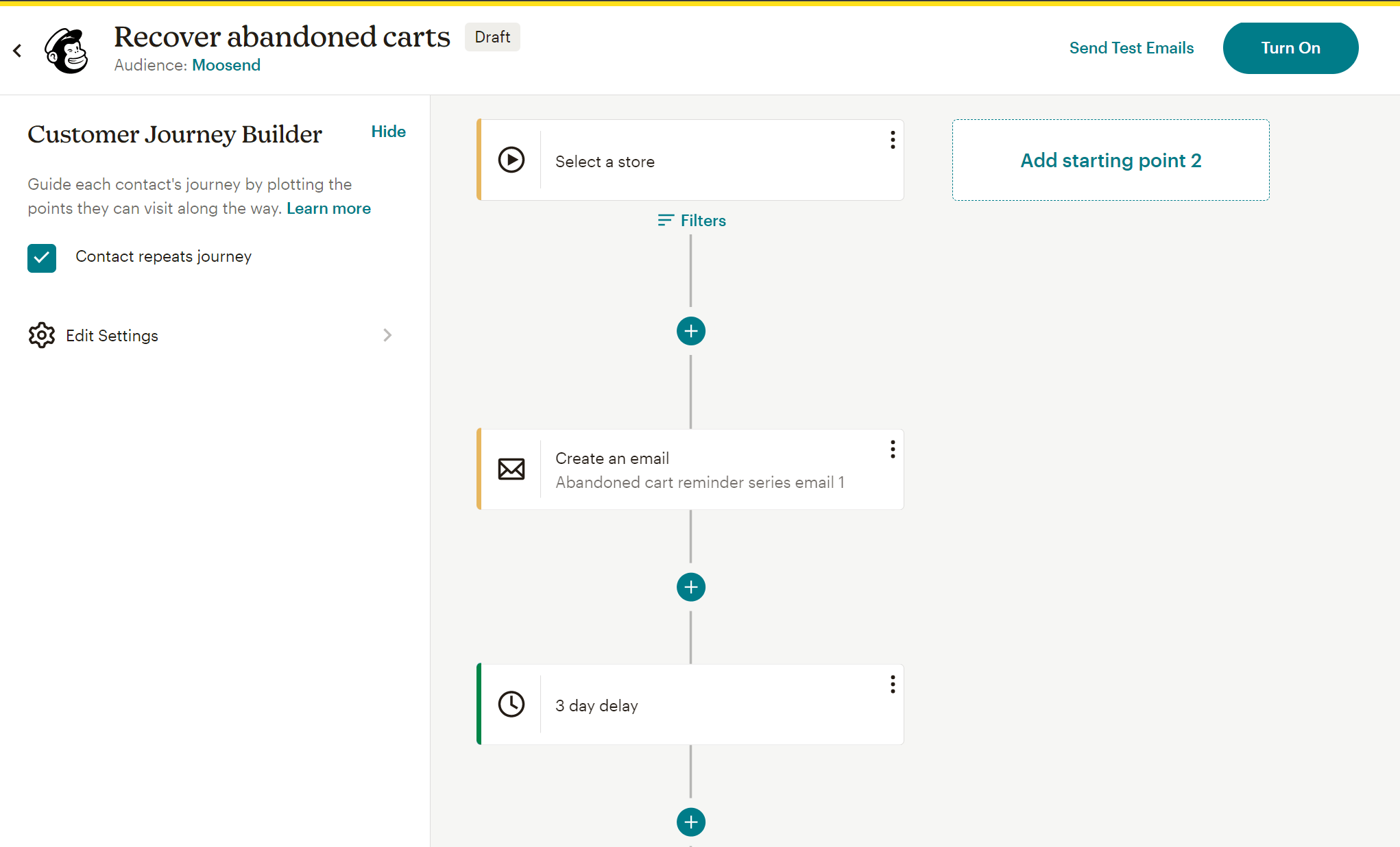
Mailchimp’s automation builder (Customer Journey Builder) is a powerful tool, but not on the same level as ActiveCampaign’s. The builder has 102 pre-built journeys for welcoming new contacts, nurturing leads, sending transactional email campaigns, and more. Using the automation builder is easy, and you can choose between multiple triggers and actions for your sequences. On that note, Mailchimp’s triggers are more basic than its competitor’s. For small businesses, Mailchimp’s automation will be more than enough.
Winner: ActiveCampaign’s automation is without a doubt hard to beat.
List Management
Now let’s take a look at the list management and segmentation options of each tool.
ActiveCampaign:
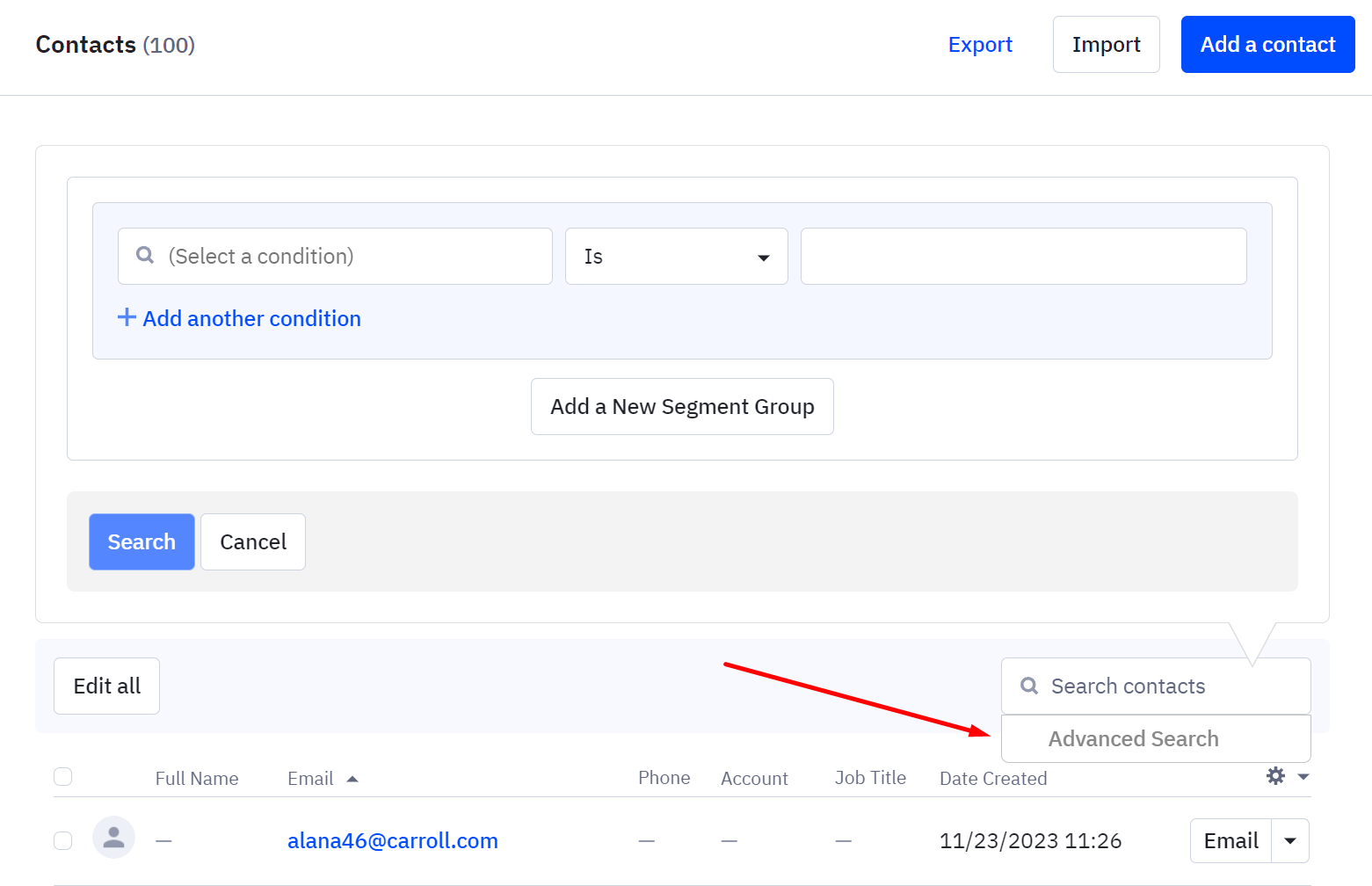
Managing contacts is easy with ActiveCampaign. If you have an existing email list, you can import the CSV file straight away or use the integration with Calendly, Google Sheets, and Typeform. To segment your audience, you can select various criteria such as products purchased, website visits, industry, customer lifetime value, and geographic location among others. To access the Segment Builder, you need to click on “Advanced Search” as shown above.
You can also use custom fields, which are essentially additional data you’ve collected about the contact. Additionally, you can add tags to contacts automatically and then deliver relevant content. ActiveCampaign’s editor allows you to define if contacts will be segmented into a particular list when they click on a link or image, for example.
Last but not least, ActiveCampaign has lead scoring capabilities. This means you can assign scores based on the actions that subscribers take. This is an advanced feature that differentiates the platform from Mailchimp, which has a more basic scoring feature.
Mailchimp:
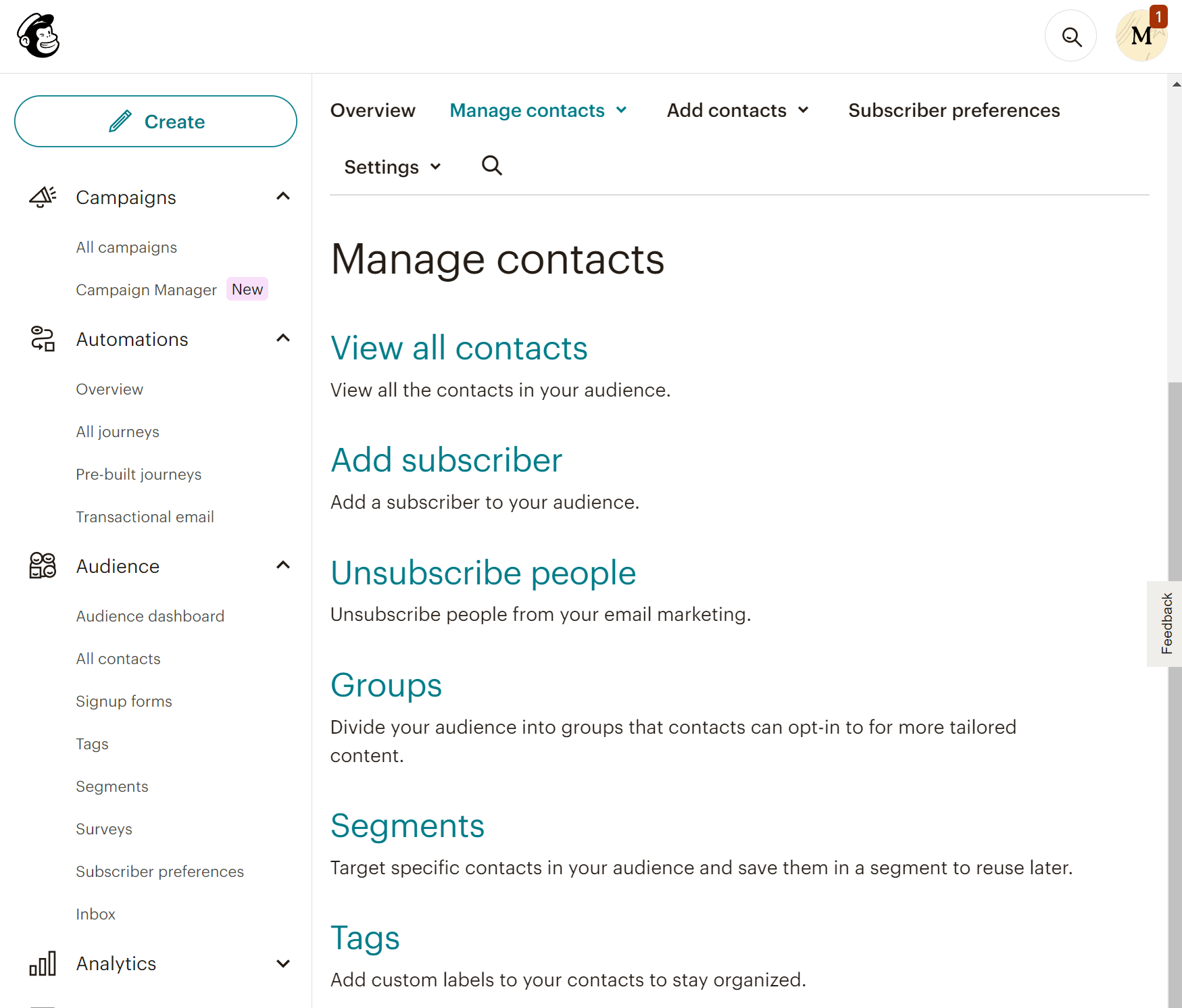
List management is different in Mailchimp. The main difference is that email lists (audiences as Mailchimp calls them) are siloed. Essentially, it’s not possible to include contacts on different audiences in the same campaigns. What’s more, if a subscriber is on more than one list, you still pay for that same subscriber as many times as they appear. This method of counting subscribers is costly. So Mailchimp’s email list system is only valuable if you have multiple businesses or handle many projects.
Apart from that, Mailchimp allows you to organize your contacts using tags, segments, and groups. The overall sentiment is that this feels a bit overkill since the distinction isn’t immediately clear.
Winner: ActiveCampaign. Things are much simpler on ActiveCampaign’s platform, while there are also automation actions that make list management easier than Mailchimp.
Reporting & Analytics
Now let’s move on to what the two services offer in terms of reporting and analytics.
ActiveCampaign:
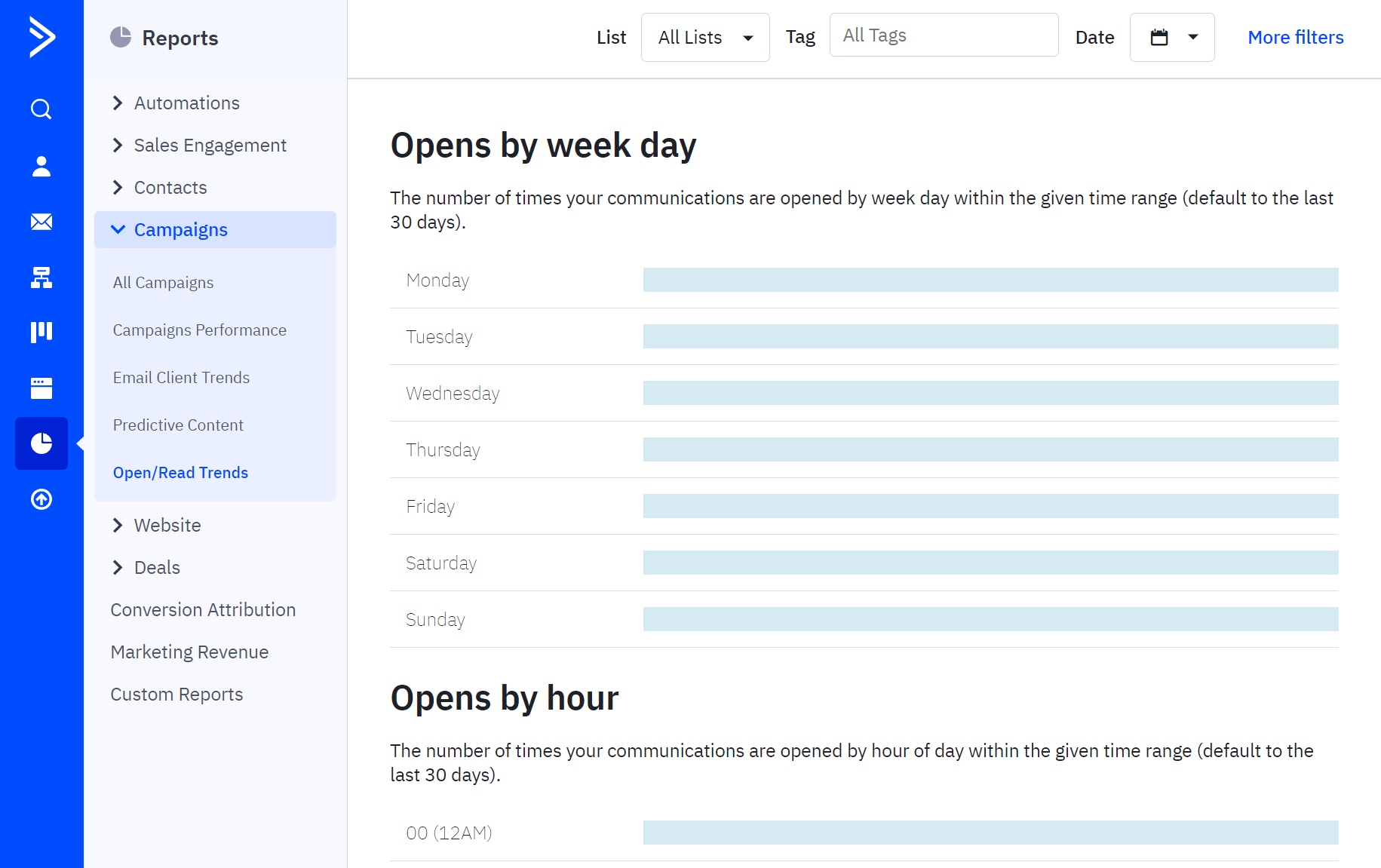
ActiveCampaign does a stellar job at tracking all the important metrics for your business. These include the open rates, click rates, unsubscribe rates, click-to-open rates, forward rates, and bounce rates. What’s more, the platform offers geolocation reports, social performance, and automation reports. There is also eCommerce revenue tracking if your store is on Shopify, Woocommerce, Magento, Square, etc.
It’s also worth mentioning that ActiveCampaign provides deal reports. These reports are summaries of your deals in the CRM system. Other reports include email client trends and open/read trends.
Mailchimp:
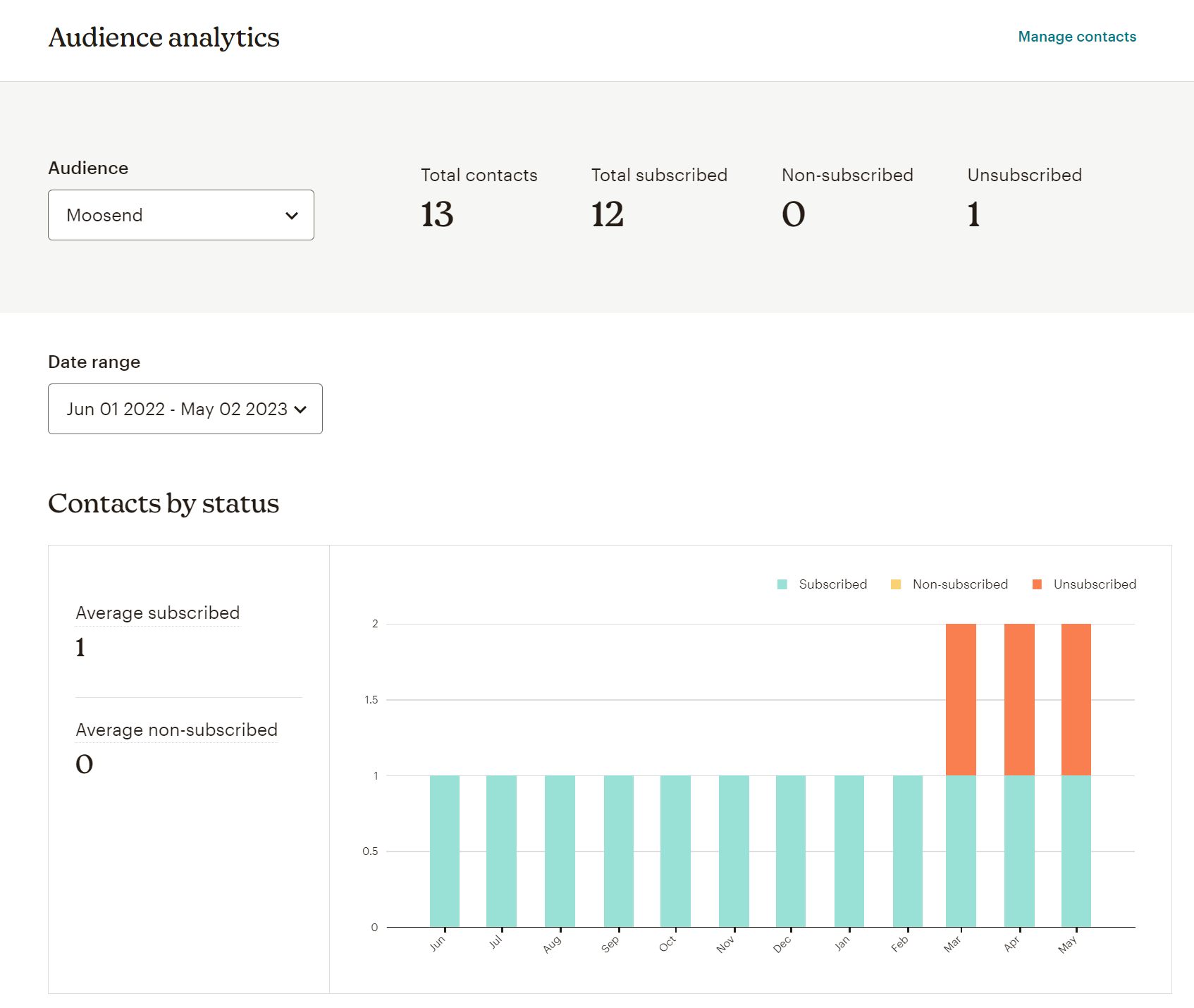
Mailchimp’s reports are equally rich and detailed. The platform tracks links clicked, opens, bounces, and unsubscribes. On top of that, you get email client statistics and social media reporting. There is also integration with Google Analytics to help with conversion tracking.
What’s also great is Mailchimp’s eCommerce reports that are available for more platforms than ActiveCampaign offers.
Winner: This is a tie! Both services offer equal reporting and analytics tools. However, if you’re also interested in deal reporting, then ActiveCampaign is the go-to.
Forms & Landing Pages
Now it’s time to look at the lead generation tools offered by each email marketing tool.
ActiveCampaign:
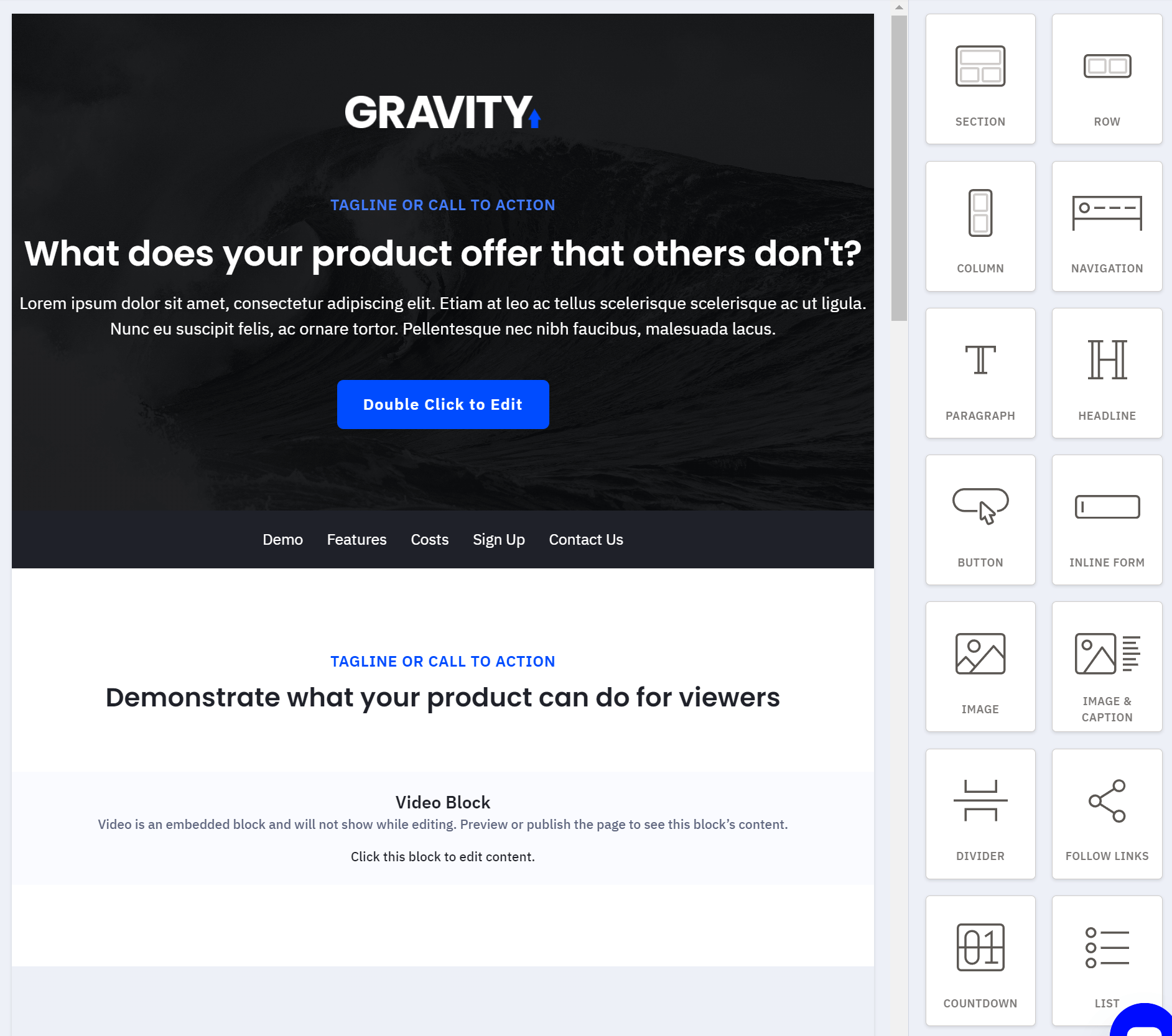
Starting with the landing pages, ActiveCampaign offers 62 responsive templates, which are also customizable. The builder itself is fast, while the process of customizing your landing page is effortless. You can craft all kinds of landing pages with ActiveCampaign, like for events, webinars, and even eCommerce promotions. Don’t expect absolute flexibility in arranging your elements since you can do this only between the outlined sections. What’s cool is the ability to sell one or more products through your landing pages via the PayPal integration. Finally, you can track page views, page conversions, and your conversion rate in the dashboard.
As for the form builder, it allows you to create regular (inline) forms as well as floating bars, floating boxes, and modal popups. You can have custom fields and specify the message users get upon submitting the form. Another great thing for eCommerce store owners is that if your store is on Shopify, you can automatically embed the form on your site instead of having to copy and paste it.
Mailchimp:
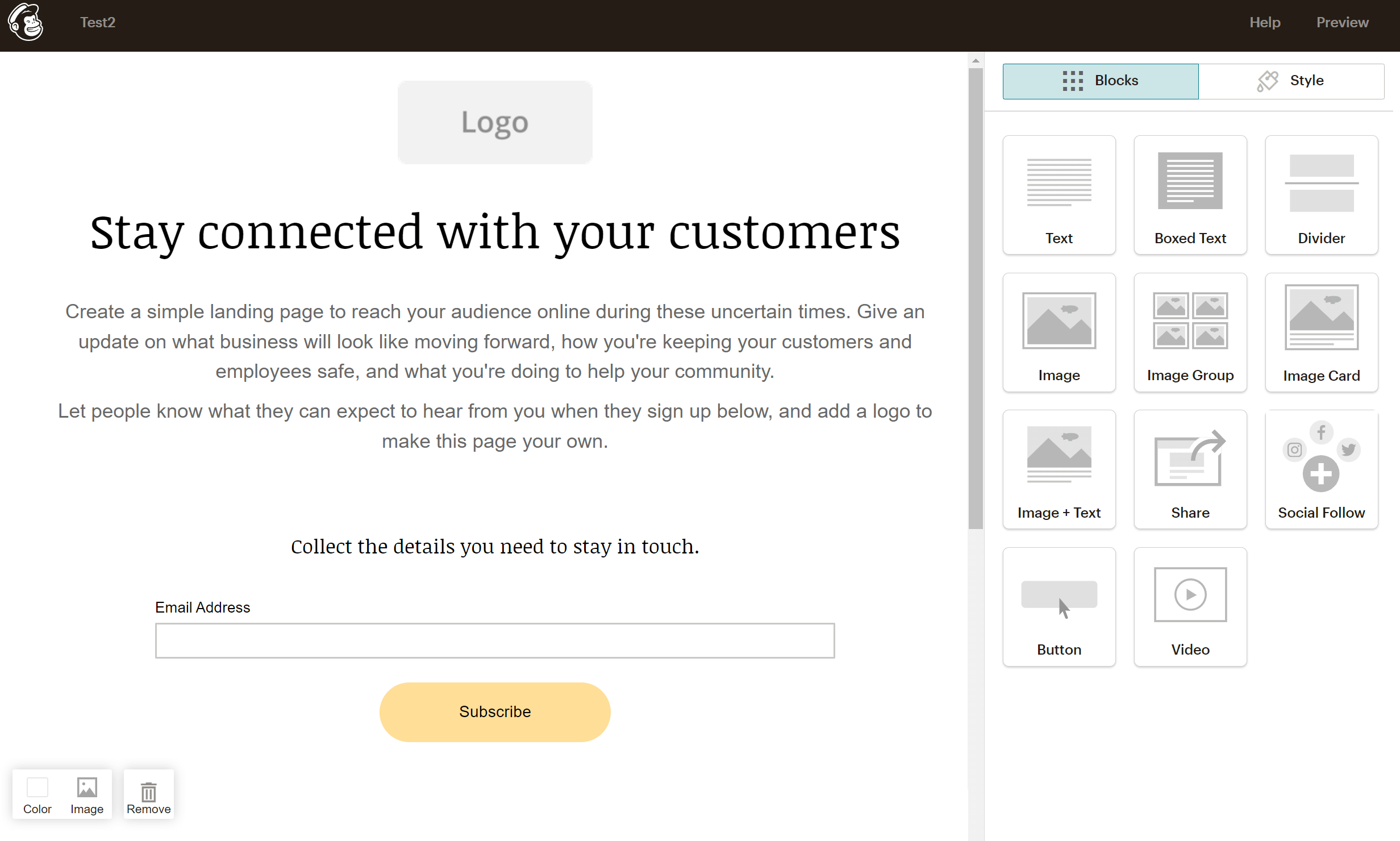
Mailchimp’s landing page builder is simple to use and offers similar drag-and-drop functionality. In contrast with ActiveCampaign, the builder sometimes feels sluggish, but nevertheless, you’ll be able to create a beautiful landing page without much effort. Similar to ActiveCampaign, Mailchimp’s landing page builder doesn’t have any advanced features that other standalone builders have.
The form builder is fairly straightforward allowing you to create embedded forms, popups, and signup landing pages. Most of the templates are responsive, while the platform offers integration with services such as WordPress and MailOptin.
Winner: Even though forms and landing pages do not come cheap in ActiveCampaign, the overall experience is better and smoother while you also get more pre-made templates to kickstart your efforts.
ActiveCampaign vs Mailchimp: Email Deliverability
Email deliverability is absolutely crucial in order for your email campaigns to be delivered to subscribers’ inboxes and not land in the spam folder. The latter would be a waste of both your time and effort. So, we’ll take a look at research conducted by Emailtooltester showing the reliability of these two email marketing services among other popular solutions. As you can see in the image below, both ActiveCampaign and Mailchimp stand at the top of the email deliverability scores.
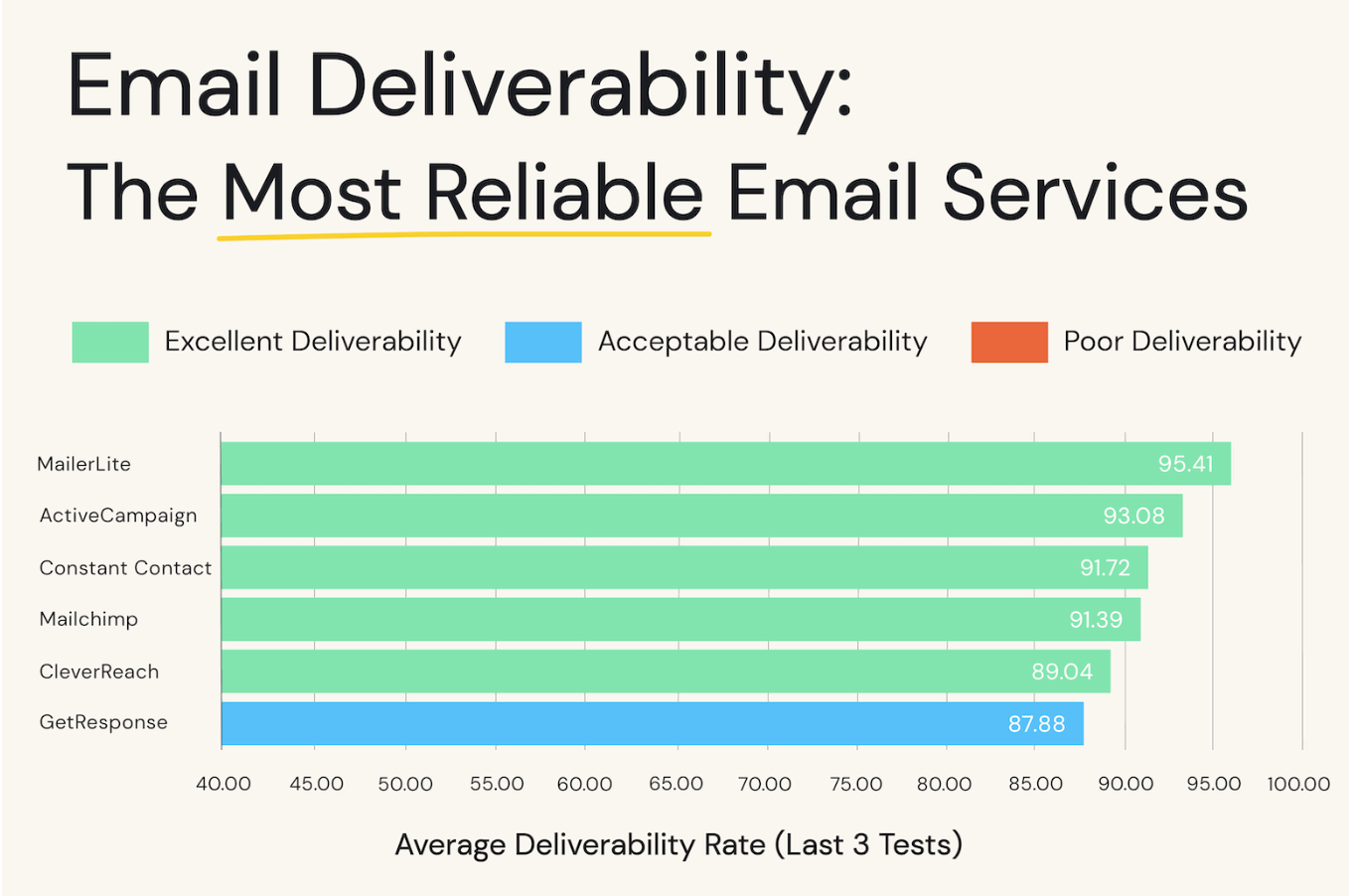
Winner: This ActiveCampaign vs Mailchimp deliverability battle is a tie. The almost 2 percent difference they have is minimal and both services will successfully deliver your messages to your target audience.
ActiveCampaign vs Mailchimp: Integrations
Integrations are very important for marketers and business owners since they connect the services they use with each other and streamline marketing efforts. Let’s see how our competitors fare.
ActiveCampaign:
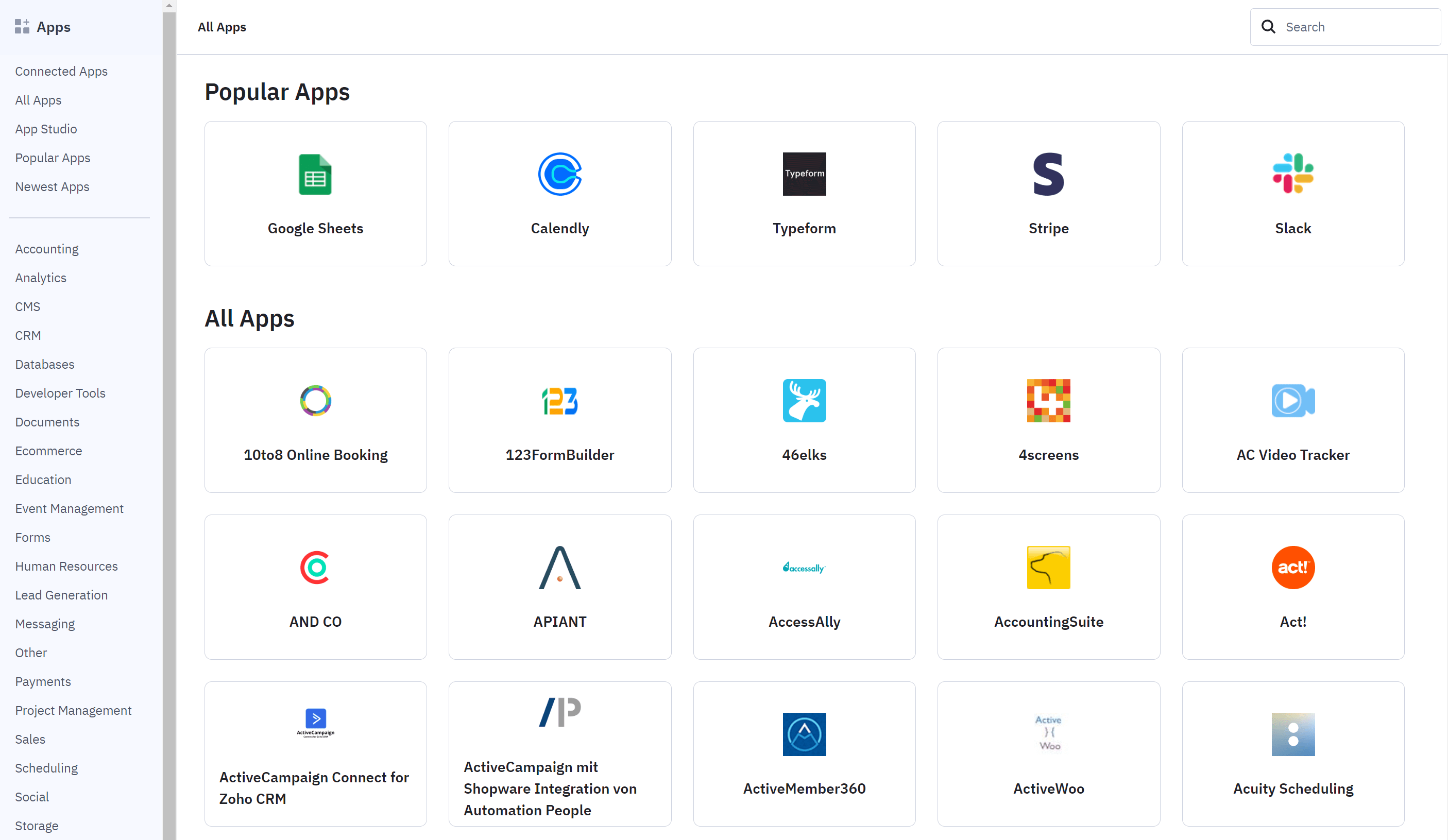
ActiveCampaign has an impressive number of 940+ services that can be integrated with it. Notable integrations include PayPal, Salesforce, WordPress, Unbounce, Eventbrite, Google Analytics, and Stripe. If there isn’t a native integration available for a tool you’re using, you can use Zapier.
Mailchimp:
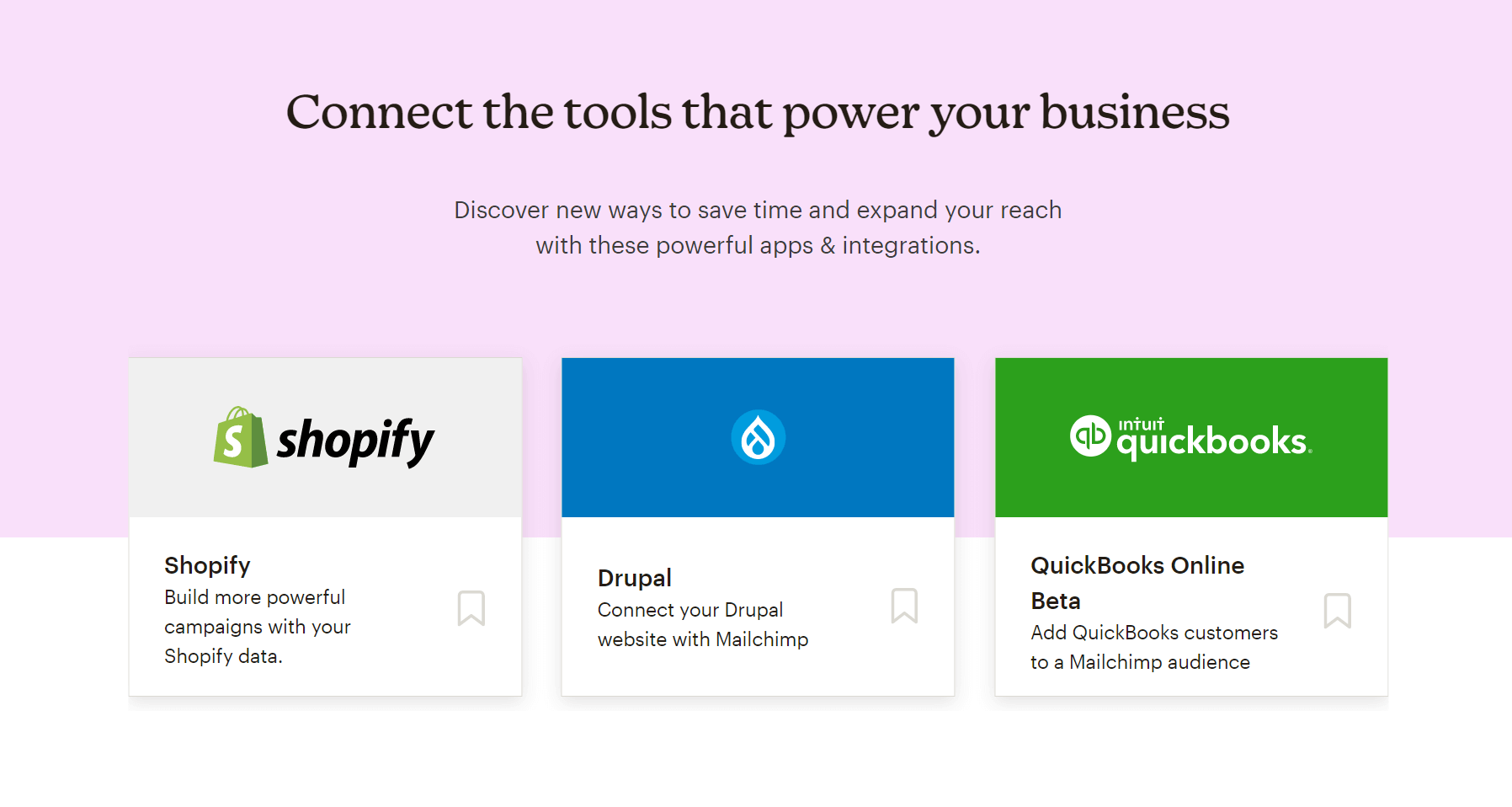
Mailchimp has a decent list of integrations available, even if they don’t reach the high number that ActiveCampaign offers. Specifically, we found 330 integrations in Mailchimp’s Integrations Directory for eCommerce tools, CRM, analytics, social media, and accounting. Zapier increases the potential integrations even more.
Winner: Based purely on the number of integrations, ActiveCampaign would be the winner. However, since both services integrate with the most popular apps that the majority of users will need, we’ll call this a tie.
ActiveCampaign: vs Mailchimp: Support
Now let’s see how Mailchimp and ActiveCampaign handle users when they need customer support.
ActiveCampaign:
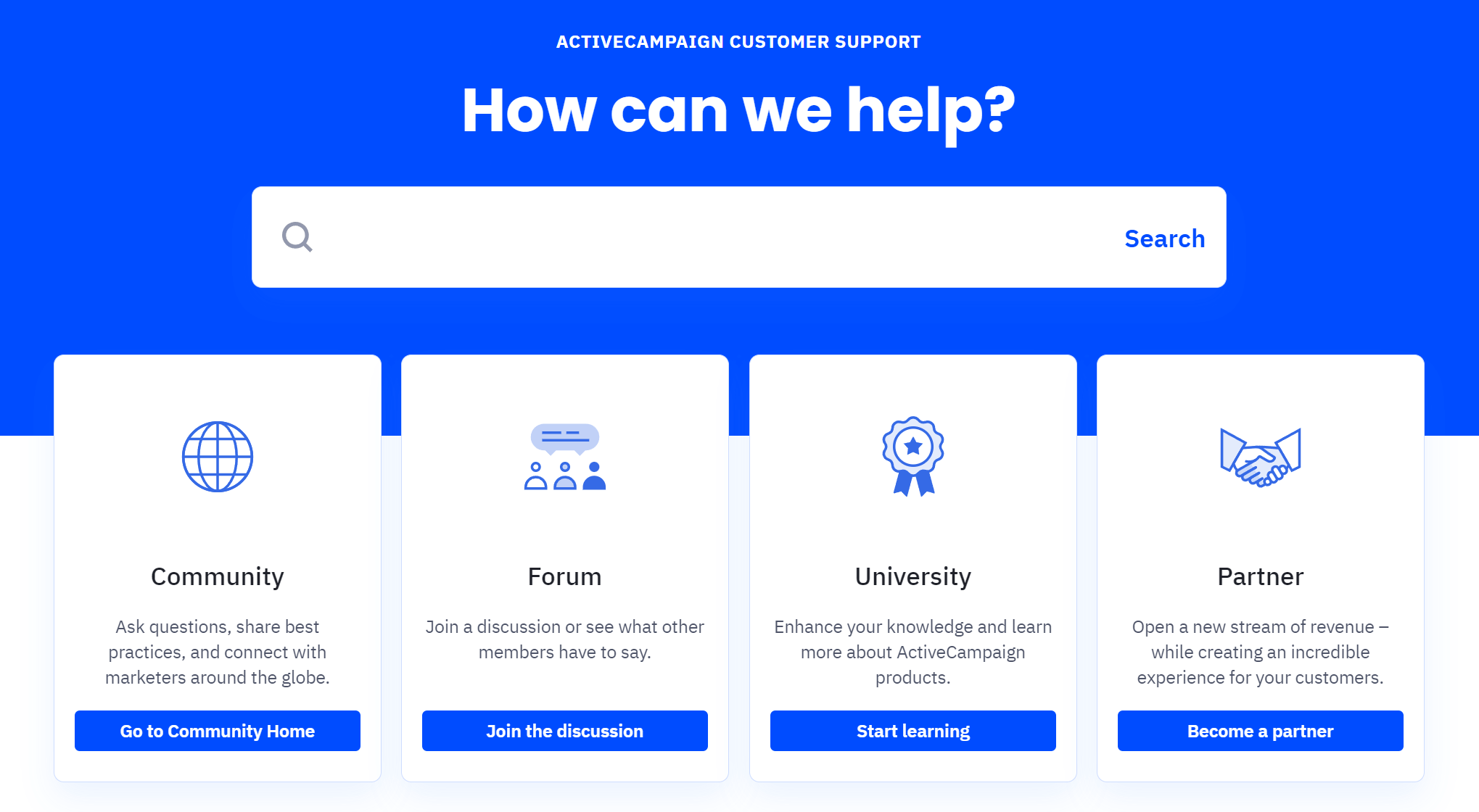
ActiveCampaign offers various channels for support. There is a Community forum, an extensive knowledge base, and other useful webinars and tutorials. The company also claims to offer 24/7 email and chat support. However, this is misleading since the help articles clearly state that the Customer Experience Team is only available Monday to Thursday from 6 am – 11 pm (CST) and Friday from 6 am – 4:30 pm (CST). For ActiveCampaign’s price tag, “true” 24/7 live support should be expected.
Mailchimp:
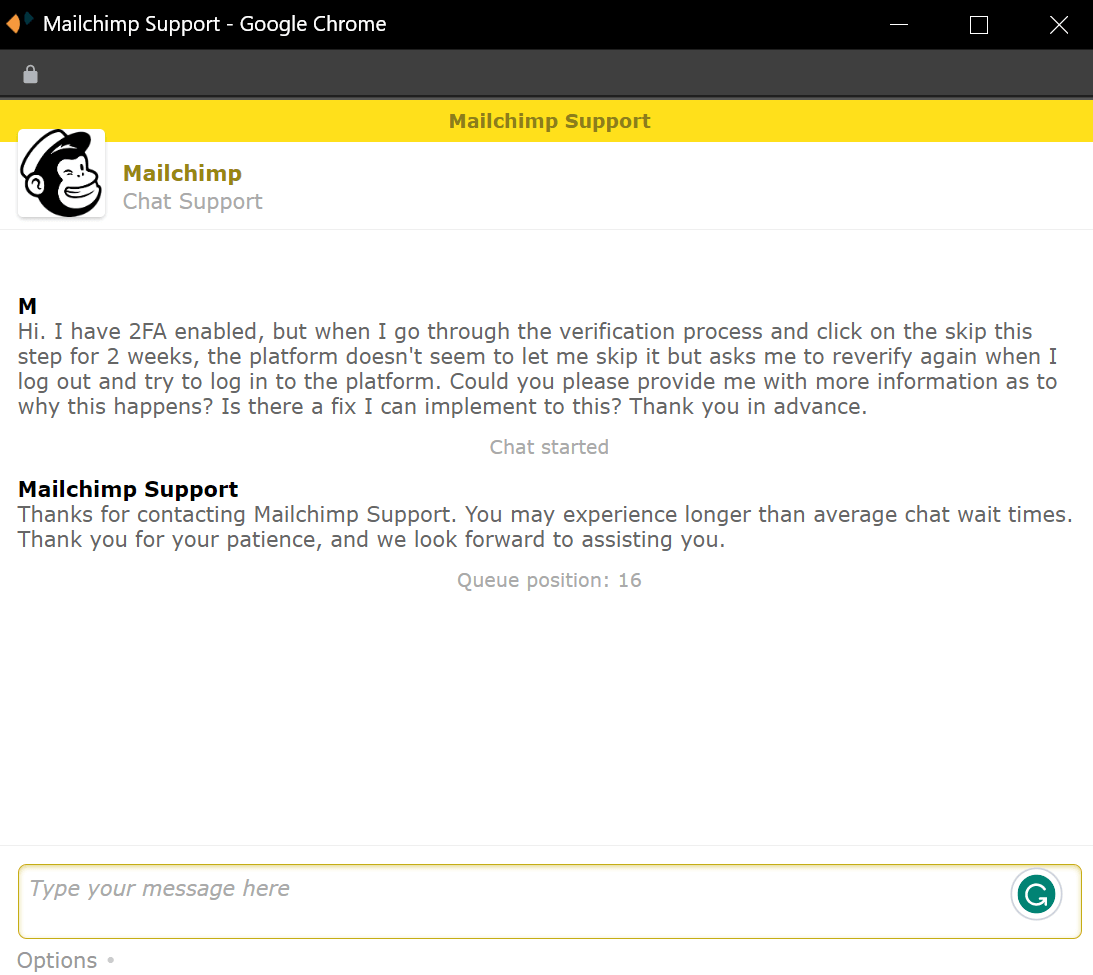
All paid plan users of Mailchimp enjoy 24/7 live chat support. For the Premium plan, there is also phone and priority support. For the free plan, the company only provides email support for the first 30 days. Finally, for users looking for the answers themselves, there is an extensive knowledge base with useful tutorials.
Winner: We give this win to Mailchimp despite the reportedly slow response times of its customer support team. ActiveCampaign should be more transparent regarding the available times that its support team operates.
ActiveCampaign: vs Mailchimp: Pricing
It’s time to compare the two tools in terms of their pricing.
ActiveCampaign:
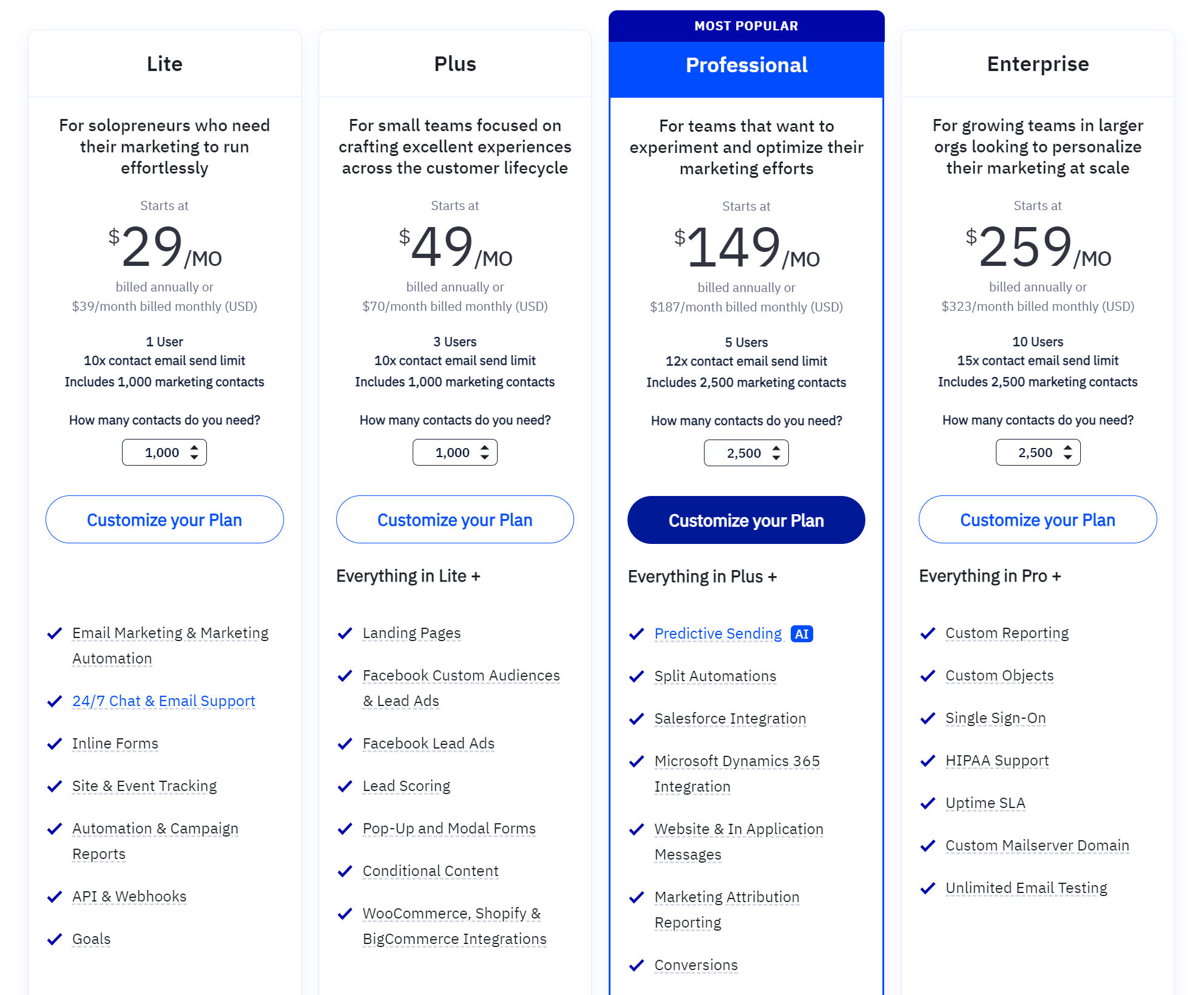
ActiveCampaign is undoubtedly on the pricier end of the email marketing spectrum. As we said though, it offers ample functionality for the price it asks. Its lowest tier plan, the Lite plan, starts at $39/month (monthly billing) but lacks forms, landing pages, conditional content, and eCommerce functionality.
The more expensive plans are more value for money, but users will need to pay a considerable amount for that additional functionality. ActiveCampaign’s pricing makes more sense if users commit to an annual subscription. Last but not least, the biggest pain point when compared to Mailchimp is the limited 14-day free trial.
Mailchimp:
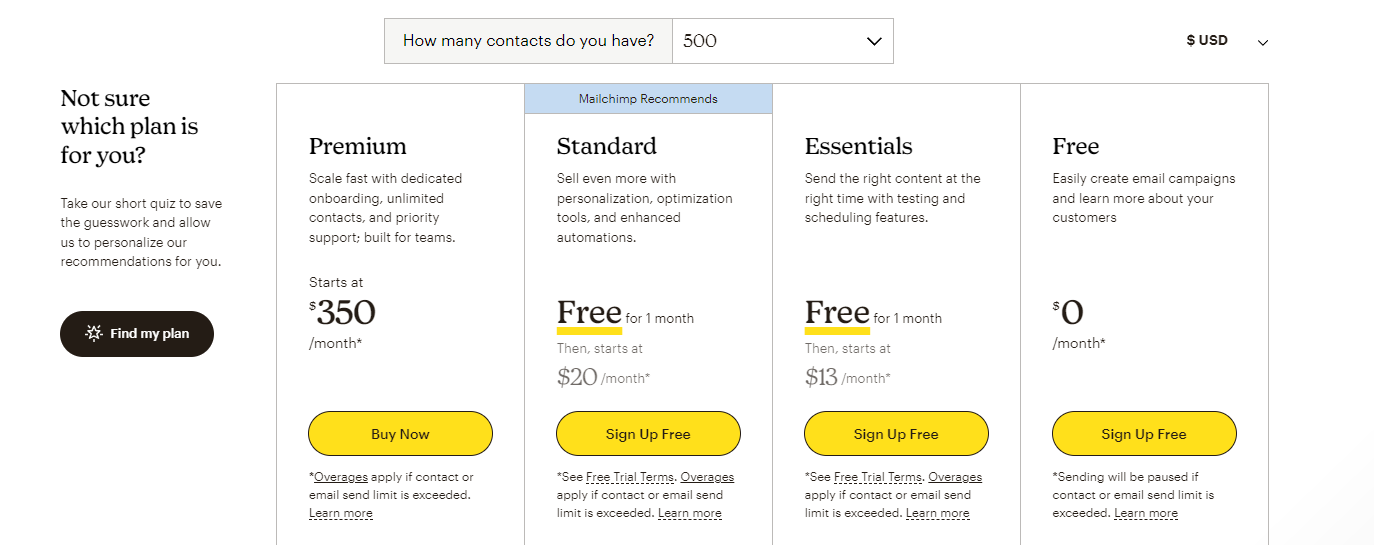
Mailchimp’s pricing structure involves three paid plans along with the free tier. The free plan, although popular in the previous years, has shrunk a lot and it only allows up to 500 subscribers and 1,000 monthly email sends. The Essentials plan provides all the important features most users need without segmentation, comparative reporting, and multi-step automation. We also noticed that if you have more than 50,000 subscribers, prices start to be similar with ActiveCampaign.
Winner: Affordability-wise, Mailchimp offers a more cost-effective solution. However, we believe that ActiveCampaign is more fairly priced for what it offers. So, taking into account the offering, ActiveCampaign is a more value-for-money option.
Top ActiveCampaign And Mailchimp Alternatives
Here are the best alternative services that you need to consider before making your final choice.
1. Moosend
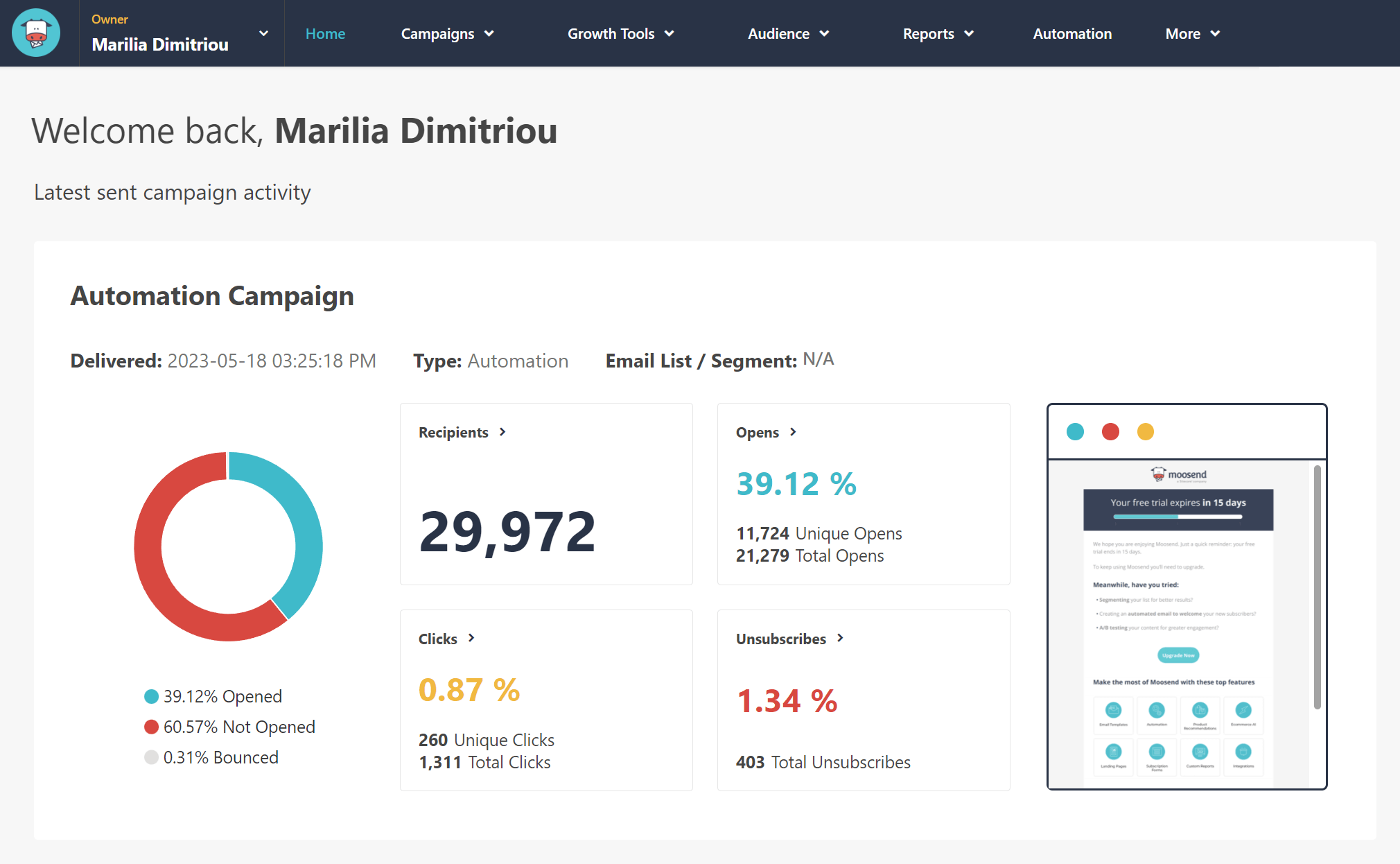
Pricing: Paid plans start at $9/month, 30-day free trial (Sign up here)
Best Feature: Powerful and affordable marketing automation
Moosend is a modern, all-in-one email marketing platform that stands out due to its intuitive drag-and-drop email builder and the robust automation options it offers. The visual workflow builder allows even beginners to build sophisticated journeys with ease, while the platform’s user-friendly interface helps reduce the learning curve. What’s also great about Moosend is its rich reporting and analytics capabilities, including real-time statistics. This way you can track your performance and optimize your strategy (using A/B testing or other strategies).
2. Brevo
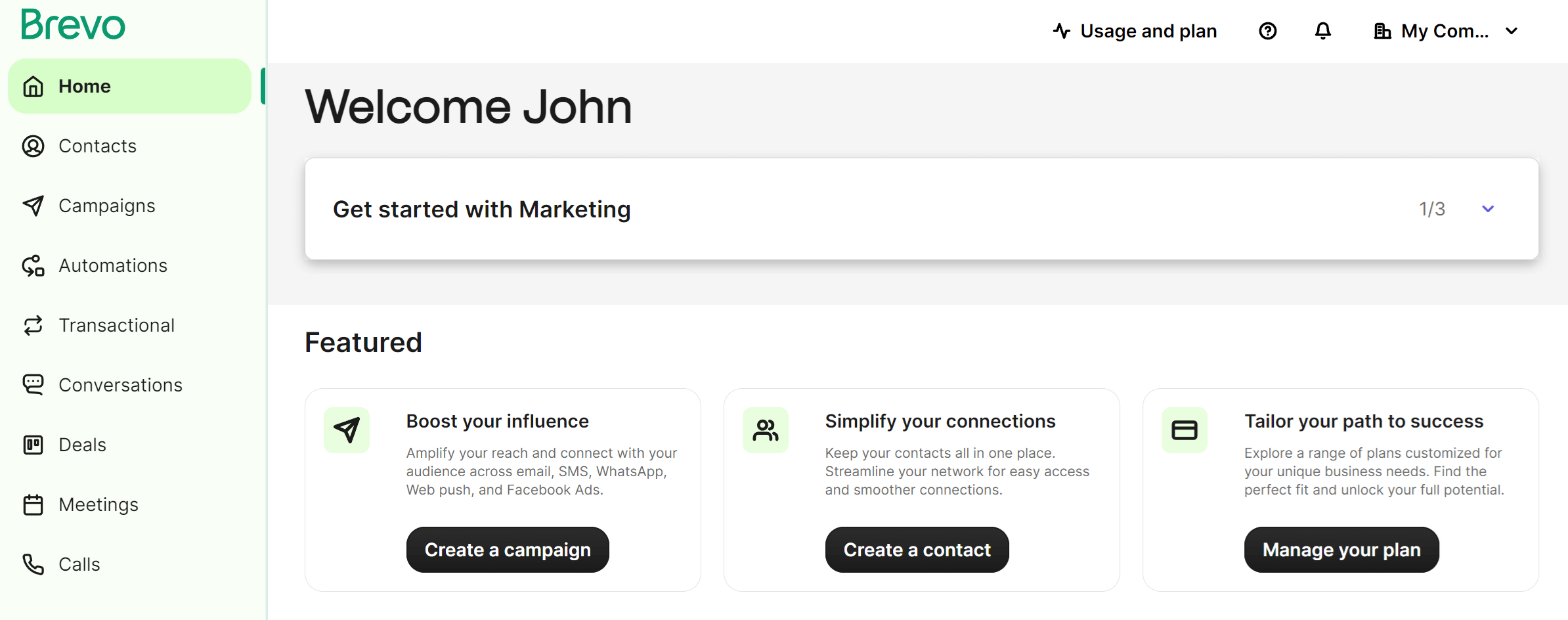
Pricing: Paid plans start at $25/month, free plan
Best Feature: SMS and WhatsApp campaigns
Brevo is a multi-channel marketing platform equipped with a CRM system. The platform allows you to have unlimited contacts without restrictions. Apart from email campaigns, you can also send SMS and WhatsApp campaigns, while Brevo can also handle your transactional messages. Brevo has robust automation options and other advanced features like send time optimization and A/B testing. As for its pricing, it is in the same range as Mailchimp and ActiveCampaign.
3. Omnisend
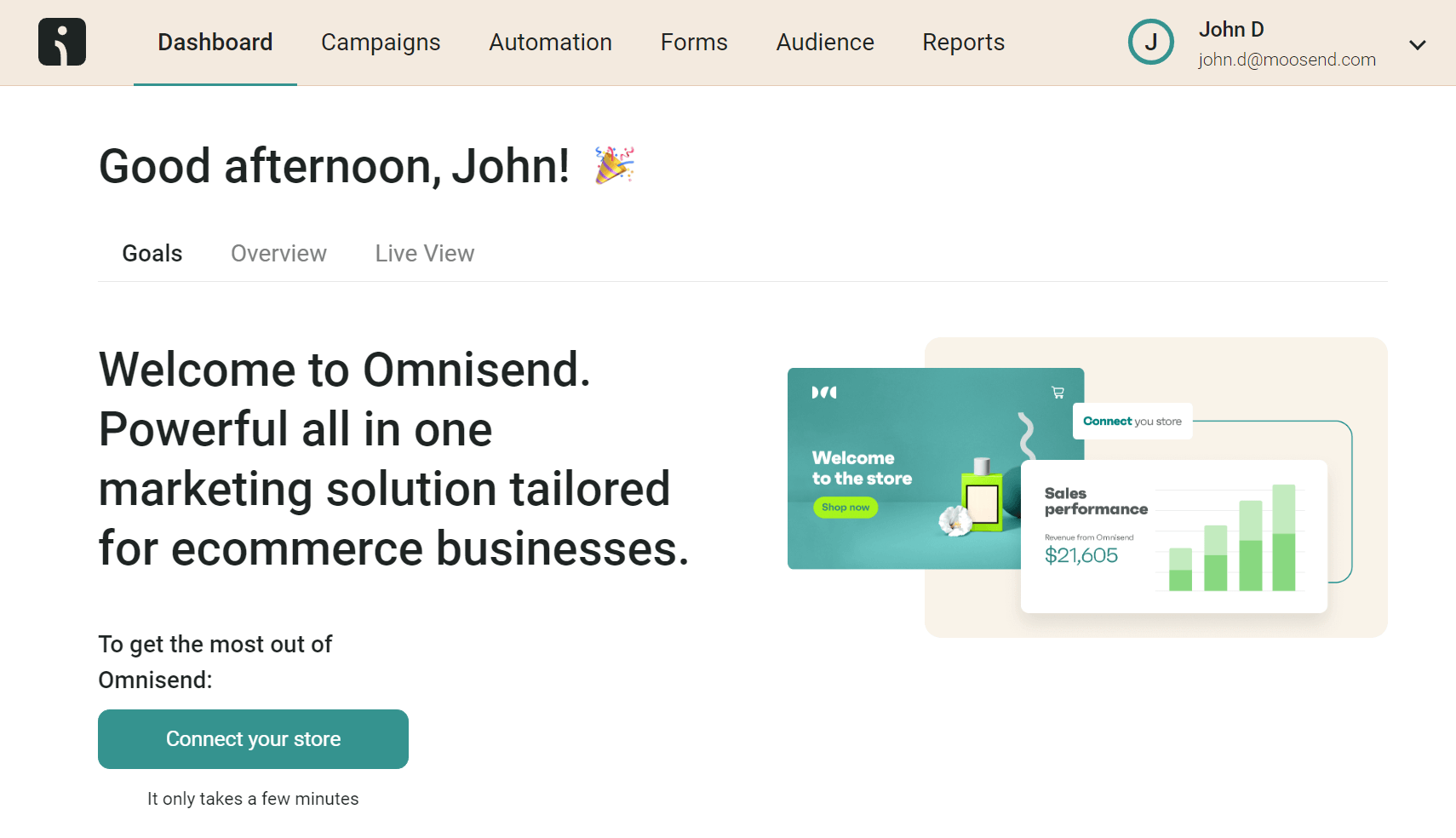
Pricing: Paid plans start at $16/month, free plan
Best Feature: Sales and performance reports
Omnisend is an eCommerce email marketing and SMS platform. It provides a nice set of tools for businesses of all sizes including marketing automation, revenue tracking, and rich analytics to keep track of your efforts. What’s also great is the advanced segmentation which helps you target the right people with the right message based on campaign activity, shopping behavior, and more.
Here are a few resources for further reading:
- Brevo Review
- Brevo vs Mailchimp
- Mailchimp Alternatives
- ActiveCampaign Alternatives
- MailerLite vs Mailchimp
- Best email newsletter software
ActiveCampaign vs Mailchimp: Final Thoughts
The aim of this in-depth comparison is to help you understand what each solution offers and identify which service best suits your needs. You need to consider multiple factors like your budget, your long-term goals, and the features that are necessary for your marketing team to deliver truly unique customer experiences. Careful consideration of the aforementioned factors will lead you to the right decision.
If you haven’t made up your mind just yet and you’re willing to try an affordable competitor that delivers robust functionality and stellar customer support, create a free Moosend account and do some testing.
The post ActiveCampaign vs Mailchimp: The Ultimate Comparison [2024] appeared first on Email Marketing Automation Platform for Thriving Businesses.
